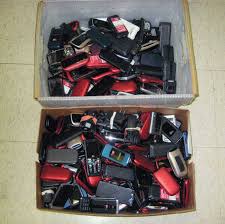Feds order cell phone access for cons in halfway houses

By Tom Steward | Watchdog Minnesota Bureau
MINNEAPOLIS, Minn. — It’s one of the most sought after, smuggled and dangerous weapons in prisons. It’s also a tool that few in the outside world make do without.
Now, U.S. Attorney General Eric Holder plans to make the indispensable items — cell phones — available to thousands of federal offenders serving out their sentences and re-entering society each year in halfway houses. More than 30,000 people spent time in federal halfway houses in 2013, according to the U.S. Department of Justice.
“For the first time, halfway houses will also have to provide greater assistance to inmates who are pursuing job opportunities, such as permitting cell phones to be used by inmates and providing funds for transportation,” states a Department of Justice March news release unveiling sweeping new regulations announced under the banner of reducing recidivism.
The Minnesota Department of Corrections has cautiously begun testing a similar concept for state offenders who participate in a work-release program and live in a halfway house. These aren’t smart phones, but rather no-frills cell phones pre-programmed with two numbers: the halfway house and 911.
“We just implemented, within the last month or so, a pilot project where we have one halfway house that has got a couple of cell phones available that offenders are allowed to use when they go out on job search status in the community,” said Ron Solheid, deputy commissioner of the Minnesota Department of Corrections community services division. ”These are very restricted cell phones. There’s no Internet capability on them.”
CAN YOU HEAR ME NOW? Corrections officials confiscate cell phones smuggled into prison due to the potential for criminal activity and harassment.
A 161-page DOJ document of new guidelines for halfway houses contracting with the Bureau of Prisons says “the use of pagers and cellular phones is commonplace. Contractors must develop policy and procedures that allow for routine use and monitoring of this equipment.”
Several people with experience in the federal residential reentry system privately expressed reservations to Watchdog Minnesota Bureau over the new cell phone policy for prisoners in transition. Their concerns reflect the security reasons prisoner cell phones remain banned in penitentiaries: the potential for criminal activity and harassment of others, in and out of prison.
The Bureau of Prisons estimates the order could affect up to 200 federal inmates in the reentry program, directed out of Minneapolis for Minnesota, North Dakota and South Dakota. Under Holder’s order, each of Minnesota’s three halfway houses for federal offenders — two in the Twin Cities, one in Duluth — must make cell phones available to prisoners and promulgate guidelines to control usage.
“It’s a new initiative and, obviously, all the bugs would have to be worked out. Given the business that we’re in, we have to be diligent about what inmates have available to them,” said Alice Daddario, regional residential reentry manager for the federal Bureau of Prisons. “… It’s still under review. It’s not been approved and not been implemented.”
DOJ guidelines set conditions for cell-phone usage and monitoring. Among the provisions:
- “Cell phones will be randomly searched, with all cell phones being searched at least monthly.”
- “Cell phone photos inside the facility or on the facility property will be prohibited.”
- “No resident-to-resident phone calls will be allowed.”
Corrections officials at the state and federal levels strictly control offenders in transition to maximize a convict’s likelihood of making it on the outside.
“Most (state) halfway houses have ‘no-cell phone’ rules and certainly ‘no smart-phone” rules,’ said John Schadl, communications director for the Minnesota Department of Corrections. “We want the person to get out, focus on getting a job, getting to and from their work and not get caught up in whether they should have a Facebook page and all of that type of stuff. It’s concentrating on becoming gainfully employed and making a successful transition.”
State corrections officials believe tightly controlled access to cell phones, however, could become a useful tool for the 200 or so convicts in the state work-release program.
Minnesota allows offenders in the work-release program access to two basic cell phones paid for and provided by the halfway house in the job search process such as attending interviews. Offenders cannot call companies to seek employment, but the pre-programmed phones allow job seekers to check in on their job search with the GPS function to verify their location. So far, so good, say state officials.
“In the short time that we’ve used it, it looks like it will be an effective tool that will probably be expanded,” said Solheid of the Minnesota DOC. “We just started out in just one halfway house, it’s being looked at by the others. Again, it will be limited. It’s only used while offenders are on job-search status. Once they have a job and they have a location when they go to work in the morning, they call in from that location on a land line to let the halfway house know they arrived for accountability.”
The Justice Department’s initial announcement led to Internet rumors that federal offenders would be enrolled in the Lifeline program that provides free taxpayer-funded cell phones to many in government assistance programs. Not so, Federal Communications Commission staff told Watchdog Minnesota Bureau.
Contact Tom Steward at tsteward@watchdog.org.







